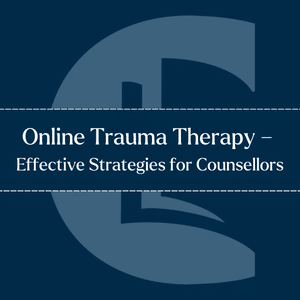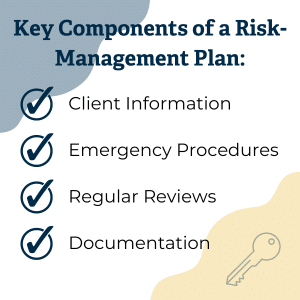Trauma Informed Practice Course
The Competence and Confidence to Work with Trauma in Your Practice.
The following article is taken from our Trauma-Informed Practice course.

The Competence and Confidence to Work with Trauma in Your Practice.
As the landscape of therapy continues to evolve with technology, working with trauma online presents unique challenges and opportunities. This article explores the complexities of ensuring client safety online, highlighting fundamental psychological phenomena, and the importance of thorough risk management. By addressing these elements, you can better navigate the intricacies of online trauma therapy and provide effective support to your clients.
Online Trauma Therapy – Effective Strategies for Counsellors

Ken Kelly: Online trauma therapy, the effective strategies for counsellors.
Rory Lees-Oakes: Yeah, online counselling is now become a standard offering within the counselling portfolio, whether you work as a private practitioner, student counsellor, health care provider, a charity, or even the NHS.
These are becoming standard offerings. I think the first thing I would say, before we even get into the trauma piece, is that anybody who works online should do some form of training around working online. There are psychological processes that appear online, that don’t appear in the therapy room.
So the first thing is make absolutely sure that you’ve done some form of training course in online and telephone counselling. And I think straight off the bat, one of the psychological processes that is really present is Disinhibition Effect. It was a psychological theory developed by an American psychologist called John Suler, and he actually found its origins in online gaming and people becoming disinhibited online.
And now we see that in quite a few areas of online activity, such as posting on social media posts, where people say things they wouldn’t usually say or act in ways they wouldn’t usually actface-to-face. We have to be very thoughtful of the disinhibition effect, because it can affect not only ourselves as therapists, but also clients. So we have to have a good understanding of the theory, but also a good understanding of how that might present in the online therapy space.
Ken Kelly: Ah, yes,
I just want to echo what you said, Rory, around the importance of training and undertaking a dedicated online and telephone counselling course. If you look to your ethical body, no matter where you are in the world, I’m almost willing to bet that they’re going to have suggestions that you do not work online until you’ve done adequate training in that.
And there are areas that can trip you up and end up, potentially, not serving our clients to the point that it can be damaging in the relationship. And you don’t know what you don’t know. That’s why the training is so important.
Rory, you mentioned John Suler, his disinhibition effect and how that shows itself online.
And one of the thoughts I have on that is, you see it in online dating apps. You swipe left if you think the person’s not for you and right if you think they are, I don’t know if I’ve got that right, it might be the other way around. But I wonder if you’d be able to do that in person, would you be able to swipe someone left or say, no, not you, maybe you, not you. We wouldn’t do that in person. And that just shows how our activity online, when there’s that feeling of anonymity, changes how we act and behave. And it changes how your client acts and behaves, and how they will show up.
Understanding that in depth, how it shows itself, and what you can do to work with that so, important. Now, with speaking about the topic of online trauma therapy, we need to understand the psychology behind it first. That’s why we’re laying this groundwork. The next one is the Black Hole Effect, also from John Suler, where he speaks about in a face-to-face setting, I’m in the same room as you, when we come to the end of a session, you’re gonna stand up and you’re gonna leave, and that is expected. And if you’re angry in the session as a client, and you don’t wanna be there anymore, then you’ve gotta say, I’m leaving now, and you’re gonna stand up and walk out and storm out, but at least I know what happened as the therapist.
Black hole effect is what happens if the client disappears. Just gone. Because think about it, online, being in the room and not being in the room is the click of a mouse, and it happens within a second. What happens if the client goes away? Where does that leave you feeling? What have I done? It may have been their internet. It may have been their choice. We don’t know what happens.
So the black hole effect is recognising that it can abruptly end. It can leave you and the client with a lot of feelings around that, that are unresolved. Cause when the person’s gone, they’re gone, and what is the plan around that?
So these are the kind of foundations, and of course we wouldn’t be able to lay the foundations without speaking about Fantasy Attachment as well.
Rory Lees-Oakes: Yes, it’s an interesting idea, fantasy attachment, and I think it possibly points towards those who work on the phone, because you can only hear a voice at the other end of the telephone.
Sometimes what can happen is that clients can build a fantasy of who you are, and there may be some transference in that. They may think of you as someone that they’ve met in their past and they can fantasise about who you are, and also about what their relationship with you is.
Where you think of all sorts of aspects of a relationship, not just the counselling relationship. It could be someone fantasising about having a different form of relationship with you. And I think that fantasy attachment, black hole, disinhibition, are all underpinnings of what can happen if someone becomes traumatised. These are things that need very careful managing because with traumatised people, it doesn’t take much to push them into deeper trauma or disassociation. So it’s essential that anybody who works online along with the management mismanagement plan, which we’ll talk about has an understanding of if the relationship is starting to drift.
The research tells us that the therapeutic relationship is one of the main ingredients in positive outcomes for therapy. If we can manage things like fantasy attachment, black hole effects, disinhibition effects, we will be in a better position to be able to build that therapeutic relationship.
In terms of fantasy attachment, I think a good observation here is make sure you have a picture of yourself on your listing, or your website, so the client actually knows who you are. I think that’s just really important so they can put a face to the voice if you’re working on the phone. May not always be achievable if you’re working for an organisation, but this disconnect that can happen with fantasy can really leak in to disassociation. And before you know it, you might have a disassociated client on the other end of the phone.
Ken Kelly: 100 percent, Rory. And when you’re speaking about that phenomena, fantasy attachment, I’m reminded of my own life where I would listen to the radio a lot. One day I came upon a picture of the DJ that I’d been listening to probably for years and I said, he doesn’t look like he sounds.
That’s fantasy attachment, because I’d made a picture of what this person is.
Like you say, Rory, having who you are and what you look like, specifically if working on phone, or via text or email, really, really important.
So the person has the reality, and at least an anchor of who you might be. And then of course, risk management is crucial. Develop a robust risk management plan, which includes gathering comprehensive client information, having clear emergency procedures.
We’re talking about trauma here. Trauma is really important, what we don’t want to be doing is, within the moment where we might see that there’s massive distress within the room, trying to work out what we’re going to do. We do the planning beforehand. I think this is an area that we can speak about just for a moment, Rory, because I think this is vital.
You would, of course, get your client information when working online, but you’re also going to get your client’s location. Now, if somebody is coming to you face-to-face, it may be you have no need to have their home address for any reason. But when you’re working online, you need the client’s location.
You need to have emergency contacts of people other than the client that you can contact. You might not ask for that kind of information in a face-to-face setting. Your risk management plan is also going to look at your emergency procedures. Can you tell us Rory, why is it important that we have client information, their location and emergency contacts?
Rory Lees-Oakes: If you’re in a therapy room and someone becomes unwell, physically unwell, say someone has an epileptic fit, or someone has a heart attack, or someone just becomes really unwell. What one would do, certainly here in the UK, is dial 999, and ask for an ambulance and medical assistance.
We would have a singular location, our practice room, and the ambulance would be able to go there. But if you’re working online with someone, and all of a sudden they become ill, unwell, they fall over, and you haven’t got their details, who are you going to send them to?
You could call 999 and say I think my client’s having a heart attack. Where are they? I don’t know. I’m working online. That is the main reason we have those details, so that should anything happen. We hope for the best, but plan for the worst.
Now, it may never happen in practice, but it only has to happen once. That is the reason we get the name and address details, and also an emergency contact, preferably someone who knows they’re having therapy.
It may be that they confide in someone and say, I’m see a therapist. Maybe that person, the best friend or a family member, so that we could call them and gain assistance quickly.
And it’s something you don’t even think about when you’re working in the room face-to-face, you never think of having someone’s name and address. Although, it is good practice to take comprehensive details. You’re online, you’re on the phone, the client becomes unwell, they need medical attention, you have their details, you can guide medical services to their location and hopefully get the support they need.
Ken Kelly: It is so important. And this brings us to our next point, which is utilising mental health questionnaires. I’m going to hand this over to you, Rory.
This is an important topic. Why is this important? Now we’re talking here about you being a therapist and maybe being happy to work with trauma online. Why would we need these mental health questionnaires and how do they serve the client, Rory? Are they not just for collecting data and reporting?
Rory Lees-Oakes: I think a lot of people think that CORE or PHQ 9 are really for reporting, and stats, and they’re done in organisations to be able to justify funding.
But actually they have a very serious function. If we take core 10, which is one of the more popular forms of assessment, it’s basically a scoring grid where you ask a number of well thought out questions. And depending on the answers, you can score that, and it may be that there’s an underlining issue.
Remember, not all clients tell you what’s going on for them. Some clients may not want to voice what’s going on, but by using the questionnaire and using the scores from it, you could look at it and say it looks to be like from what you’ve said, your response is that you’re slightly depressed at the moment, slightly anxious.
So that’s very useful. And also useful to use through the arc of therapy to see where the client is. You could use the questionnaire again, and it may be as they’re getting through the arc of therapy, they find that things get better. It’s an evidence base for the client to see that they’ve answered questions that actually are showing them that they’re feeling better. It reinforces the therapy.
Now, when we get into things like PHQ 9, I want people to really listen to this. Sound like an ex tutor now, don’t I?
Is that there’s a risk assessment for suicidal ideation. And we can no longer have low, medium and high risk for suicide. It may be when we do the questionnaire, it comes out like that, but we have to continually assess. There’s been a huge change in the assessment of suicidal ideation, and that’s been driven by the National Institute for Clinical Excellence, which is a UK based organisation that quality standards, not only medication, but also risk assessment.
So just because someone is referred to, and they’ve got a very low risk of suicidal ideation, it’s up to you to assess it within the relationship, not to dogmatically rely on a assessment that’s been done by somebody else. Really important. But it does give us again, PHQ 9, much the same thing, but it does give us a baseline to work on.
Should the client become unwell or say they’re going to take their own life, we can make a decision about that. And maybe we have to refer, or break confidentiality. If that is in your contract, that’s another story, how we put that in your contract, so that we can support them.
Sometimes when people are feeling very low, they may not make the best decisions. And sometimes with a bit of extra help and another few days, they may have been glad that someone intervened and helped them gain time to make a better decision, whether they should or shouldn’t take their lives.
Ken Kelly: Wow. It’s such a consideration, isn’t it? Working with trauma online demands a heightened awareness of unique psychological effects and the implementation of rigorous safety protocols. And I think that by understanding phenomena such as the Disinhibition Effect, and Fantasy Attachment, and developing the comprehensive risk management plans, therapists just go on to provide a safe and effective online therapy for those seeking.
The disinhibition effect refers to the phenomenon where clients feel less inhibited in online environments, leading to greater disclosure than they might offer in face-to-face sessions. This over-disclosure can pose challenges for therapists, as clients may later regret sharing more than they intended and disengage from the therapeutic process. Understanding this effect is crucial for managing client expectations and for maintaining therapeutic boundaries.
The black-hole effect – another term coined by American psychologist John Suler in the 1990s (Suler, 2023, pp. 70-71) – describes the anxiety often felt by people when their communications appear to vanish into the void without immediate feedback. This can be particularly problematic in online therapy, where delays in responses can exacerbate clients’ anxieties. To mitigate this effect, you need to establish clear communication protocols and backup plans, such as switching to telephone communication if video calls fail.

In the absence of physical presence, clients may form fantasy attachments to their therapists, imagining them as perfect figures. This can complicate the therapeutic relationship and make the termination of therapy more challenging. You must be aware of this dynamic and address it proactively, helping clients to maintain realistic perspectives.
Online Trauma Therapy – Effective Strategies for Counsellors
Before working online and/or by telephone, you must undergo training in online and telephone counselling so that you understand this medium’s unique risks and requirements. Ethical bodies and practitioners stress the necessity of these skills to ensure safe practice. The training should cover psychological aspects, safety considerations, and the development of a risk-management plan.

Mental health questionnaires, such as PHQ-9 and Beck’s Depression Inventory, provide valuable insights into a client’s mental state and help identify risks like suicidal ideation. These tools support ethical decision-making and ensure that therapists can make informed choices about their client’s care.
Standardised mental health questionnaires can provide valuable insights into the client’s psychological state and help in ethical decision-making. Counselling Tutor (2024, ‘Using Mental-Health Questionnaires’ section, para. 2) writes:
As well as providing evidence-based information to support your decision-making on whether or not it is safe and ethical to work with a particular client, using a standard tool as part of your assessment for all clients can help reduce the feeling of invasiveness.
Commonly used questionnaires include:
These tools are helpful for initial assessments and can also be used throughout the therapeutic process to monitor changes and adjust treatment plans accordingly.
Working with trauma online demands a heightened awareness of unique psychological effects and the implementation of rigorous safety protocols. By understanding phenomena such as the disinhibition effect and fantasy attachment, and by developing comprehensive risk-management plans, therapists can provide safe and effective online therapy.
Continuing professional development, peer discussions and supervision are essential for maintaining competence and ensuring the best outcomes for clients. As online therapy continues to grow, staying informed and prepared will be vital for successfully navigating its challenges.
While online trauma therapy presents distinct challenges, it also offers significant opportunities for reaching clients in new ways. Therapists can effectively support their clients through their healing journeys by adhering to best practices and by remaining vigilant about safety.
Online Trauma Therapy – Effective Strategies for Counsellors
Counselling Tutor. (2024). Risk Assessment in Online Therapy [online]. Counselling Tutor. [Viewed 30/5/22]. Available from: https://counsellingtutor.com/managing-risk-in-online-therapy/
Kelly, K. and Lees-Oakes, R. (2021). Online and Telephone Counselling: A Practitioner’s Guide. Warrington: Counsellor Tutor Ltd.
Suler, J. (2023). The Psychology of Cyberspace: The Classic Text [online]. John Suler. [Viewed 9/7/24. Available from: https://www.johnsuler.com/pdfs/psycyber.pdf
Notice any broken link or issues with this resource? Kindly let us know by email
Email us